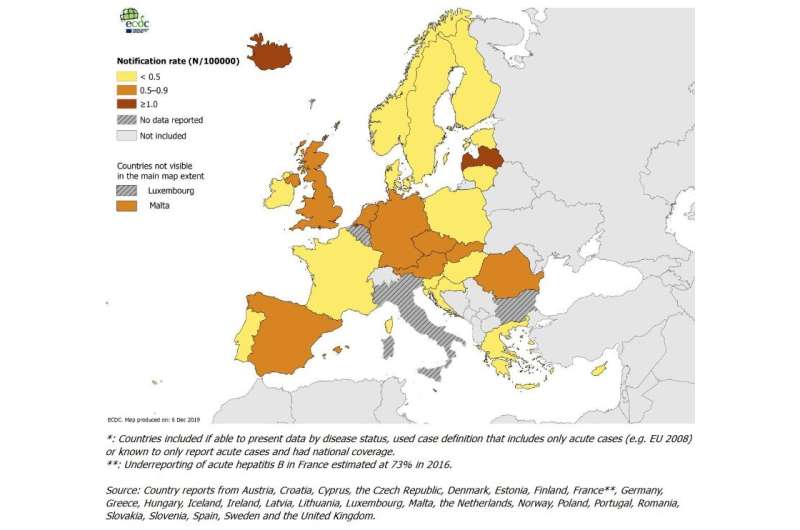The number of newly diagnosed hepatitis B infections reported from countries across Europe remains high, with the majority of these infections classified as chronic. A marked variation between countries in the distribution of acute and chronic cases was observed. This geographical variation most likely reflects differences in local testing and reporting practices as well as underlying epidemiological differences. Credit: ECDC
Approximately four in five people living with hepatitis B and three out of four people with hepatitis C infection across the European Union and European Economic Area (EU/EEA) and the UK have not yet been diagnosed. This is a major obstacle on the way towards the Sustainable Development Goal (SDG) for health in 2030 as highlighted by ECDC on occasion of World Hepatitis Day.
ECDC is working in close collaboration with the World Health Organization to monitor the progress towards the elimination of hepatitis B (HBV) and C (HCV) across the EU/EEA. The first progress report highlights major gaps in prevention programs in the region with suboptimal HBV vaccination coverage and insufficient levels of harm reduction targeting people who inject drugs.
The report shows that robust data for the so-called continuum of care looking at the numbers of diagnosed people and those in treatment and care are lacking in most countries. However, available data suggest that a high proportion of people living with hepatitis B and C infections appear to be undiagnosed and that many of those who have been diagnosed with hepatitis B and C infection are not receiving life-saving treatment. Available evidence also indicates that those at high risk of infection, including people who inject drugs and people in prison, are not being effectively targeted for testing.
In addition, mortality related to viral hepatitis is high across the region and there is very little evidence of progress towards the 2030 elimination target of a 65% reduction in mortality against the 2015 baseline.
"Looking at the latest monitoring results and surveillance data in 2020, we have to conclude that we are not on track to reach the 2030 target. To get there, Europe needs to massively scale up efforts to reduce the number of people who have never been tested for hepatitis B and C, especially among people at most risk of infection," highlights ECDC Director Andrea Ammon on occasion of World Hepatitis Day on 28 July. "Safe and effective vaccines are the main pillar for hepatitis B prevention. In addition, effective hepatitis treatment exists and improves the health of those who receive it. Treatment also helps preventing further transmission. It is as simple as that: people need to know their hepatitis status if we are to make progress towards eliminating these diseases by 2030."
European surveillance data show on-going transmission of hepatitis B and, despite a recent slight decline, high annual levels of hepatitis C diagnoses.
But according to recent ECDC findings, only a few countries across the EU/EEA have met the 2020 target of the European Action Plan to diagnose 50% of people with chronic hepatitis.
The ECDC testing guidance provides an overview of effective strategies to identify those with undiagnosed infection and highlights the importance of community testing and the integration of testing services (e.g. HIV and hepatitis) to enable synergies and efficiency in times of resource constraints.
Early diagnosis and linkage to care bring strong individual and public health benefits: effective viral hepatitis treatment either eliminates or suppresses the viruses significantly which in turn means that those on treatment interrupt existing transmission chains, preventing further infections.
The European Test Finder makes it easy to locate testing sites for HIV, hepatitis and sexually transmitted infections across Europe.
More information: European Test Finder: www.testfinder.info/
Provided by European Centre for Disease Prevention and Control (ECDC)
























